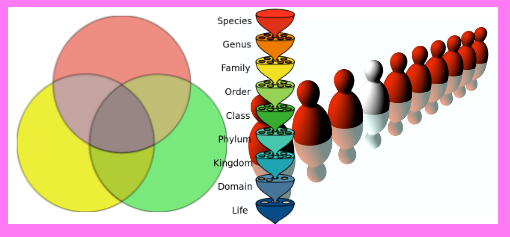


Summary of What Research Says: Things that improve student’s ability to understand and use knowledge:
- explicitly identifying similarities and differences
- asking students to identify similarities & differences
- representing similarities & differences in graphic or symbolic form (see below for ideas)
Classroom Practice in Classifying Similarities & Differences:
- Comparing
- Teacher directed
- Teacher specifies objects to compare & characteristics to use for comparison
- Student directed
- Students select objects to compare and/or characteristics to use for comparison
- Graphic organizers
- Teacher directed
- Classifying
- Teacher directed
- Teacher specifies objects to classify and classification categories
- Student directed
- Students are given objects to classify and form categories themselves
- Graphic organizers
- Classifying / categorizing graphic organizer in 46 graphic organizers
- Classification worksheet
- Classification graphic organizer
- Teacher directed
- Metaphors
- Teacher centered
- Need to help students realize that 2 items in metaphor are connected by abstract relationship
- Teacher provides 1st element of metaphor and helps students identify abstract relationships
- Student centered
- Should follow teacher centered scaffolding. See above.
- Students are given first element and asked to come up with 2nd element and abstract relationship.
- Graphic organizers
- Teacher centered
- Analogies
- Helps students acquire new knowledge by comparing them to more familiar things
- Takes form A is to B as C is to D
- Most complex form of identifying similarities and differences
- Teacher centered
- Teachers provide a lot of supporting structures such as
- providing examples and asking students to explain why they make sense
- present analogy with one missing item
- Teachers provide a lot of supporting structures such as
- Student centered
- Students provide more elements than in teacher centered tasks such as
- provided with 1st pair and they provide 2nd pair
- Students provide more elements than in teacher centered tasks such as
- Graphic organizers
- Analogy organizer
- See Analogy graphic organizers in The Teacher Toolkit: Graphic organizers
- Graphic organizers for analogies
- See Analogy graphic organizers in Identifying Similarities & Differences

Identifying similarities and differences can help students build bridges between new and familiar knowledge. Research has shown that identifying similarities and differences helps students deepen their knowledge and transfer their knowledge to new contexts.

Preparation Steps
- Identify which concepts could be good to pair with identifying similarities & differences strategies
- Gather and refine related graphic organizers and related examples of identifying similarities & differences strategies
Early Implementation Steps
- Facilitate teacher centered activities at first to build specific skills related to identifying similarities and differences
- Use timely descriptive feedback to help students reflect upon, explain, and refine the connections they are making with these strategies
Advanced Implementation Steps
- Facilitate more student centered versions of identifying similarities & differences strategies activities after other activities have modeled and given practice opportunities to students on prerequisite skills

- See Rigor articles
